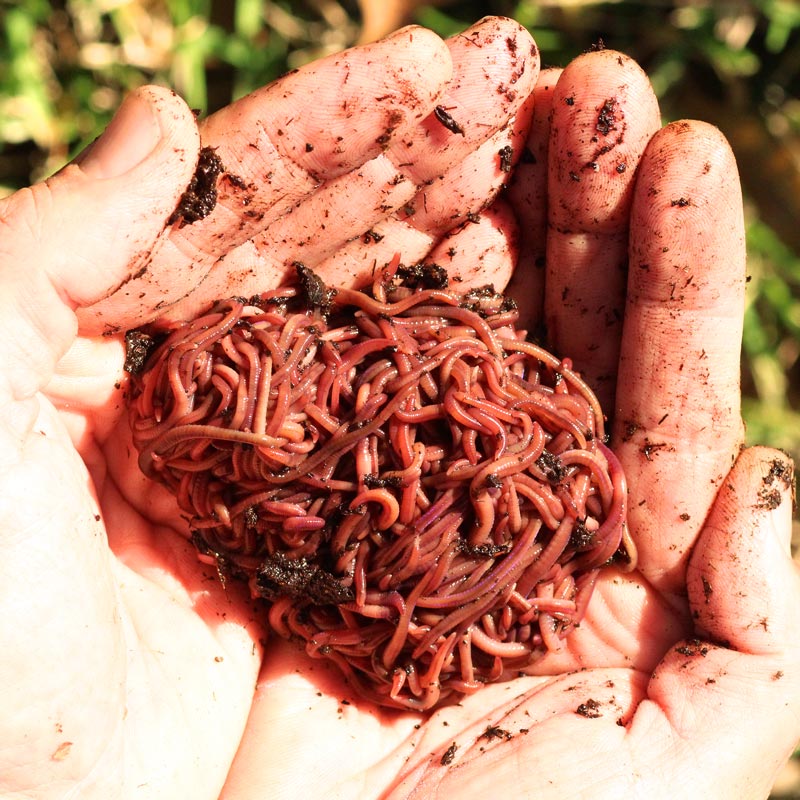Organic Composting with Red Wiggler Worms - Increase Your Yard's Development
Organic Composting with Red Wiggler Worms - Increase Your Yard's Development
Blog Article
Maximizing the Conveniences of Red Wiggler Worms: A Comprehensive Guidebook for Home Gardeners and Urban Farmers
In the world of sustainable horticulture methods, red wiggler worms stand as unrecognized heroes, silently changing natural waste right into nutrient-rich spreadings that can function wonders for soil health. By checking out the details of how to efficiently care for and take full advantage of the advantages of red wiggler worms, individuals can unlock a riches of chances for boosting the sustainability and productivity of their gardening endeavors.
Comprehending Red Wiggler Worms
Red Wiggler worms, renowned for their effective composting abilities, are a varieties of earthworms commonly utilized in vermiculture techniques. These worms, clinically understood as Eisenia fetida, grow in decaying natural product, making them perfect candidates for composting.
One trick feature of Red Wiggler worms is their reproductive price. These hermaphroditic creatures possess both male and female reproductive organs, permitting them to replicate quickly under desirable problems. A fully grown Red Wiggler can create several children in a short duration, ensuring a consistent population within a composting system.

Establishing a Worm Container
When developing a worm bin for vermiculture purposes, correct prep work and attention to information are crucial for producing a conducive atmosphere for Red Wiggler worms. Begin by selecting a suitable container for your worm container.

Area the worm bin in an awesome, dark area away from direct sunlight and severe temperature levels. Routinely keep track of the moisture degrees, including water if the bed linens really feels completely dry or half-cracked. Feed the worms a well balanced diet of fruit and veggie scraps, staying clear of citrus fruits, onions, and spicy foods. By following these steps, you can set up a prospering worm bin that will efficiently refine natural waste right into nutrient-rich vermicompost for your garden.
Feeding and Keeping Worms
Making certain a well balanced and nutritious diet plan is essential for the wellness and efficiency of Red Wiggler worms in a vermiculture system. It is essential to avoid feeding them citrus fruits, onions, garlic, milk items, meat, and oily foods as these can be hazardous to the worms or trigger undesirable odors in the bin.
Correct moisture degrees are likewise critical for the wellness of Red Wiggler worms. The bed linens ought to really feel like a moist sponge, giving sufficient dampness for the worms to breathe with their skin. Routinely inspect the dampness degrees and adjust by adding water or dry bed linen material as needed. In addition, maintaining proper temperature conditions in between 55-77 ° F(13-25 ° C )will certainly make sure ideal worm task and recreation. By diligently checking their diet regimen, wetness, and environmental conditions, home garden enthusiasts and urban farmers can sustain a healthy and efficient Red Wiggler worm populace for composting purposes.
Harvesting Worm Spreadings
To efficiently extract nutrient-rich worm castings go to website from the vermicompost, a methodical harvesting procedure is crucial for maximizing the composting advantages. The first action in harvesting worm spreadings is to encourage the worms to move to one side of the bin.
After the spreadings have been gathered, it is essential to divide any continuing to be worms from the castings to stay clear of hurting them throughout storage or application. One reliable technique is to create conical heaps of castings under intense light. Worms will instinctively move far from the light, permitting simple splitting up and removal.
Finally, the harvested worm castings must be saved in a trendy, dark, and dry location to keep their quality and efficiency as a nutrient-rich dirt amendment. By complying with these actions, home garden enthusiasts and urban farmers can make the most of the advantages of red wiggler worms in their vermicomposting systems.
Making Use Of Worm Castings in Gardening
The consolidation of nutrient-rich worm spreadings right into yard soil can substantially enhance plant growth and general dirt wellness. Worm castings, also recognized as vermicast, are an all-natural fertilizer created by red wiggler worms as they damage down raw material. These castings are rich in crucial nutrients like nitrogen, phosphorus, potassium, and advantageous microorganisms that promote plant growth and enhance soil structure.
When using worm spreadings in horticulture, it is important image source to mix them completely right into the dirt or utilize them as a leading dressing around plants. The slow-release nature of worm spreadings makes sure a steady supply of nutrients to plants in time, lowering the risk of nutrient leaching and promoting long-lasting soil fertility. Additionally, worm spreadings aid boost dirt aeration, water retention, and microbial activity, creating a healthy and balanced atmosphere for plant roots to thrive.

Verdict
In conclusion, the utilization of red wiggler worms in home horticulture and city farming can dramatically profit soil health and plant growth. By recognizing just how to establish up and preserve a worm container, feed the worms appropriately, and harvest their nutrient-rich spreadings, garden enthusiasts can make best use of the advantages of these earthworms.
In the realm of sustainable horticulture methods, red wiggler worms stand as have a peek at these guys unsung heroes, silently changing organic waste right into nutrient-rich spreadings that can work wonders for soil wellness.When establishing a worm bin for vermiculture purposes, correct prep work and interest to detail are crucial for developing a helpful setting for Red Wiggler worms. The initial action in collecting worm castings is to encourage the worms to migrate to one side of the container. Worm castings, also recognized as vermicast, are a natural plant food produced by red wiggler worms as they damage down organic issue. By understanding just how to set up and keep a worm bin, feed the worms effectively, and harvest their nutrient-rich castings, garden enthusiasts can optimize the advantages of these earthworms.
Report this page